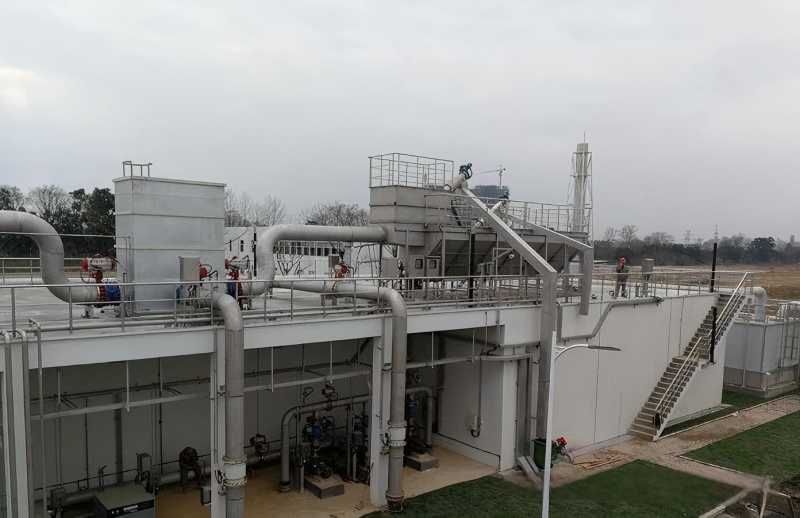Marketing Hotline:
(+86)0532-88988868
(+86)0532-88988868
First, the core process principle
1. Chemical precipitation
Dehardening: Add lime (Ca(OH)₂), sodium hydroxide (NaOH) or sodium carbonate (Na₂CO₃) to react with calcium and magnesium ions to form calcium carbonate (CaCO₃) and magnesium hydroxide (Mg(OH)₂) precipitation.
Silicon removal: Magnesium oxide (MgO) or magnesium chloride (MgCl₂) is added to combine with silicate (SiO₃²⁻) to form insoluble magnesium silicate (MgSiO₃) precipitation, or to promote the flocculation of silicon by adjusting the pH.
2. Membrane separation technology
Tubular membranes (such as PTFE membranes) or ultrafiltration membranes are used to intercept suspended solids and colloids generated by chemical precipitation through screening filtration to ensure that the effluent turbidity and silicon content meet the standards.
3. Ion exchange method
To further remove residual calcium and magnesium ions, H-type or Na-type cation exchange resins are commonly used to reduce the hardness of water and prevent subsequent reverse osmosis membrane scaling.
Second,Typical process flow
1. Pretreatment
Remove large particles of suspended solids through grids and sedimentation tanks, and adjust water quality and quantity.
2. Chemical softening and silica removal
Lime/soda ash, magnesium oxide and other agents were added to the reaction chamber to control the pH to 10-11, and the reaction generated calcium magnesium precipitate and magnesium silicate floc.
3. Solid-liquid separation
Solid-liquid separation is carried out by using tubular membranes or high-density tanks, and the membrane separation can directly retain particles and avoid the time-consuming problem of traditional precipitation.
4. Ion exchange
The residual hardness of the filtered water is further removed by ion exchange resin, the pH is adjusted to 4.5-5.5, and then the pH is dealkalized by a decarburizer, and then the pH is adjusted back to 9-11.
5. Reverse osmosis concentration
The softened water is treated by reverse osmosis, the produced water is reused, and the concentrated water enters the evaporation crystallization system for further treatment.
Third,Key operational points
1. Drug dosing control
According to the water quality, the calcium, magnesium, and silicon content are monitored in real time, and the dosage of lime, soda ash and other agents is accurately controlled to avoid scaling or treatment substandard caused by excessive or insufficient amount.
2. pH adjustment
In the chemical precipitation stage, the pH should be maintained at 10-11 to ensure that the calcium and magnesium precipitation is complete; Before ion exchange, the pH needs to be adjusted back to the acidic range (4.5-5.5) to avoid resin failure.
3. Membrane system maintenance
Regularly backwash the membrane module (e.g. with permeate or acid and alkali solution) to prevent sludge deposition leading to membrane fouling; Control the aeration intensity and keep the sludge in suspension in the membrane tank.
4. Sludge treatment
Discharge the sludge trapped by the membrane tank in time to avoid excessive concentration affecting the membrane filtration efficiency; Sludge needs to be safely disposed of or recycled after dewatering.
5. The anti-volatility ability of the system
The continuous inlet and outlet mode is adopted to stabilize the sludge concentration of the membrane tank by adjusting the sludge discharge frequency; In response to water quality fluctuations, the dosage of chemicals can be adjusted or pretreatment links can be increased.
Fourth, process comparison and selection
Chemical precipitation membrane separation: the process is short, the footprint is small, and it is suitable for high-hardness and high-silicon wastewater, but the membrane module needs to be cleaned regularly.
Ion exchange: Permeate has low hardness and is suitable for subsequent reverse osmosis, but resin regeneration will produce high-saline wastewater.
Fluidized bed crystallization: the sludge volume is small and energy saving, but the seed addition and reaction conditions need to be controlled.
Depending on the water quality characteristics (e.g. hardness, silica content, salinity) and reuse requirements, the above processes can be combined to achieve the best treatment results.


